 Conventional Attack Submarines (S631 – S638). Service 1957-1987:
Conventional Attack Submarines (S631 – S638). Service 1957-1987:Narval, Marsouin, Dauphin, Requin, Espadon, Morse.
French Cold War Submarines
La Creole class (1940) | Narval class (1954) | Arethuse class (1957) | Daphne class (1959) | Gymnote test SSBN (1964) | Le Redoutable SSBN (1967) | Agosta SSN (1974) | Rubis SSN (1979) | Amethyste SSN (1988) | Le Triomphant SSBN (started 1989)For this new cycle about French cold war submarines, we will start with an introduction, the situation in 1945 and the leased training submarines, the rebuilt, streamlined La Creole class, and the first purpose-built French postwar “submarines”, the Narval class. Symbolically, these first “patrol submarines” (with the 1960s Daphne class) retook the name of the famous 1899 Narval (Q4) that was really the first modern French submersible and launched a new pattern of diesel-electric types designed as submersion-capable torpedo boats. The next Narval would sat next to the two cold war “attack” models of the French Navy, the 1950s Arethuse class and 1970s Agosta class. There was a clear distinction between those. The experience culminated with the first SSNs of the 1970s, paradoxically built almost a decade after the First French SSBNs.
The Narval class was planned by STCAN as a 16 kts, 15,000 nm snorkel range model capable of sailing to any point of the French Empire followed by a 15-days patrol. Six were built in 1951-1960 from three yards, and they stayed in service after their 1966-72 modernization until the 1980s, apart S 633 Dauphin which lingered as experimental submarine until 1992. They were succeeded by the 12 Daphne class started in 1958 already.
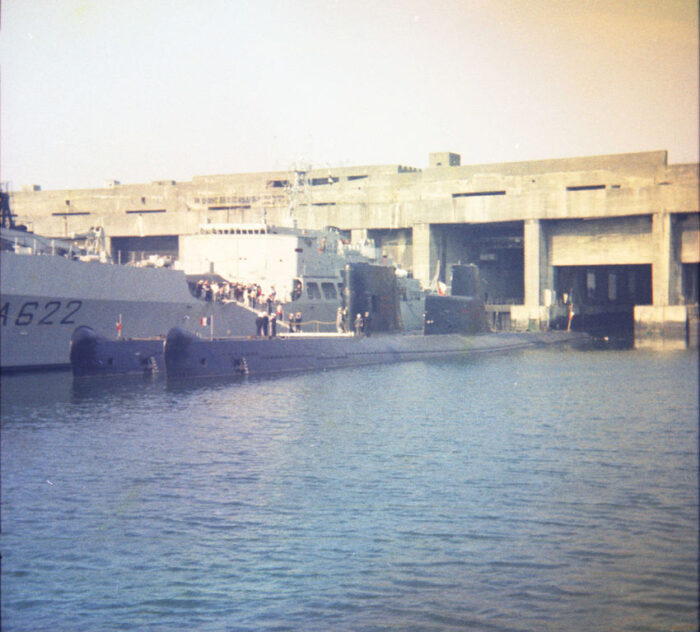
Development
The state of French submarine arm in 1950
Between models sunk under Vichy French or FNFL service, and those just worn out, there was little left of the large submarine fleet of 1939. Only four large “1500 tonnes“, two 600 tonnes and a single minelayer, the Rubis. They were discarded between 1949 and 1955. To these were added ex-German models obtained as war reparation, two from the UK, and four seized in French ports. So by 1947 only four submarines of the prewar 1500-tonne ocean-going type, two of the “2nd class” 600-tonne type, and the minelaying submarine Rubis remained. With the transfer of the ex-German boats, even these few were quickly paid off, with the exception of “Le Glorieux” and “Junon”, the latter being employed for training.
In 1946 France the six ex-U-boat were as follows: two from the UK, four seized in French ports. “Blaison” was a Type IXB, “Bouan” a Type IXC and a second Tvpe IXB, U 129, was broken up and cannibalised for spares. “Mille” and “Laubie” were standard Type VIIC boats. The fifth was a small Type XXIII (U 2326), lost accidentally in 1946. The 6th was by the far the most instrumental. Named Roland Morillot, this was a Type XXI. She was sailed and studied top to bottom, and would end having a considerable influence on French construction. Initially the allies gave no consideration to France obtaining one of these previous “wunderwaffe”. After tractation with the British government, a first was received on loan from the Royal Navy, transferred to be used extensively as a trials vessel until disposal in the late 1960s, later than any other Type XXI in service in Europe. All ex-German U-boats except Bouan had to be also overhauled and repaired before entering service as often they had been sabotaged. “streamlining them” consisted at first to remove their guns and add a snorkel if not present. In the early 1950s Bouan was the first French submarine having a streamlined fin. She was the prototype for future French submarine fins.
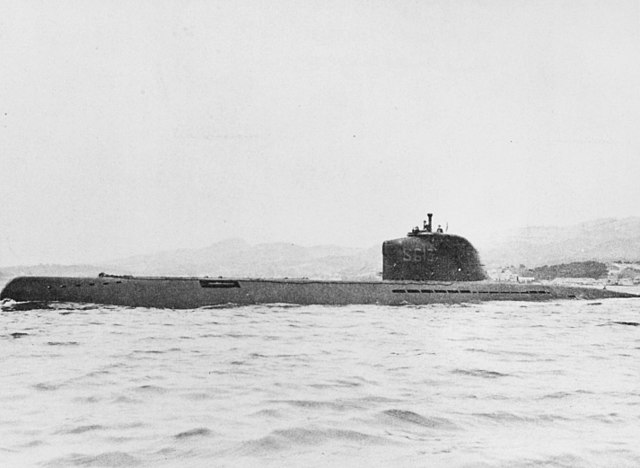
Roland Morillot, ex-Type XXI was intrumental for the rebirth of cold war French submarines
Also four Type X XVII (Seehund) midget submarines fell into French hands at the end of the war, sezized in French ports. Nos 74, 90, 107 and 365 became S 621-24 respectively. They underwent extensive testing at Toulon, and provided the inspiration for a French 30t design. Two units (Q 224-25) were to have been built under the 1956-57 programmes but the orders did not materialise. Two of the German midgets were stricken in 1954 and the other pair in 1959.
We should mention also that training submariners was a priority in 1950, and alongside the German types used as basic defensive assets, in 1951 four ex late series WW2 “S” class, demilitarized, were lent by the RN to France for ASW training. These were the Saphir class, comprising Spahir, Sultane, Sirene and Sybille, ex HMS Satyr, Statesman, Spiteful, and Sportsman. The last was lost in operations on 23 Sept. 1952 and the other three returned in 1958-61.
E-48 project
It was understood already in 1946 that France needed a modern submarine to patrol its Empire (Indochina, West Africa and Algeria essentially). Experience gained on Roland Morillot, a heavily modified Type XXI, was influencial in order to create requirements, and start working on blueprints the next year. Detailed plans were drawn up, the French navy carried out a complete evaluation of the Roland Morillot, but the resulting E-48 project was not just a plain copy of the type XXI. Indeed, the French naval staff wanted performances way above and beyond that of the German type. This helped create the characteristics of the Narval type and lead to numerous innovations.
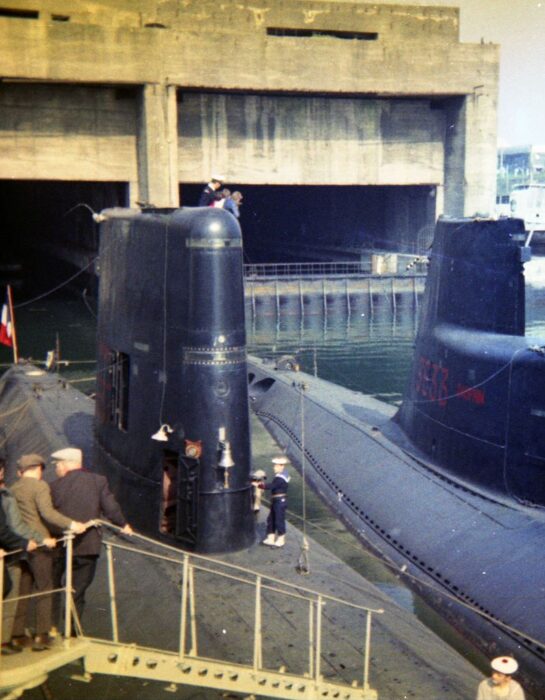
In 1947 the STCAN was asked to produce plans for a class of 1,200 tonnes standard models. Requirements included a speed of over 16 kts submerged, a range of 15,000 nm with snorkel. Long range was the overriding consideration because the continued existence of a French empire demanded the ability to make a lengthy transit and still be able to undertake a patrol of 7-14 days.
In drawing up the plans the constructors leaned heavily on experience with the ex-German Roland Morillot but also the two rebuilt, streamlined 1500t Andromede and Artémis.
Basic plans were established by General Engineer (IGGM) Dupont de Dinechin, based on the preparatory work of the engineer Isabelle. The design of these submarines was still done the old way, by a small team working by shift quite quickly. In addition Dinechin, responsible for the basic design, visited the USA in order to make a detailed study of current US Navy thinking.
The result was a much improved Type XXI, almost identical in dimensions and displacement but with greatly superior performance.
At the end of 1948, two variants of the E-48 project were presented, A and B, the difference being a large operation center in which were placed underwater detection dislays, for the G36 and Asdics microphones as well as the aerial masts, of the attack radar and surveillance radar as well as a plotter table and analogue computer for attack calculations.
On March 11, 1949, Admiral Deramond at the had of the navy, indicated to the STCAN (Service Technique des Constructions et Armes Navales) his preference Project 48B. Four days later, the program was officially launched and while final blueprints were drawn up, new equipment was installed and tested on the Andromede and Artemis. In fact seven years would pass between the launch of the project and commission of Narval, the lead boat. Two were ordered in 1949, two in 1950, and the final pair in 1954.
Construction
Innovation in construciton were numerous indeed and led to extra delays. The first four subs were ordered at the Arsenal de Cherbourg, laid down between October 1951 and February 1952, so many years after being ordered, as the yard were still being repaired from WW2 damage and rebuilt, extended and modenrized, then setup for the construction of these submarines using new methods.
Problems were experienced in developing a high-tensile steel capable of resisting pressures at the 200m max. diving depth, and the increased pressures also necessitated many changes in other areas, notably more powerful emergency blowing systems.
An exceptionally strong all-welded double hull was adopted. Hull-form, propellers, rudder and driving planes were all the subject of intensive studies. The Cherbourg-built boats were assembled in prefabricated sections each 7m x 10m — the first French submarines constructed by this method. The action information and fire control centre was based on that developed in Artémis, as was the fin with its raised section aft. The latest detection equipment was fitted.
Design of the class
The Narval type was an offspring of the E-48 project, inspired by the German Type XXI U-boats of the Second World War, particularly Roland Morillot which were brought into French service.
Compared to the Type XXI, the Narval class introduced an entirely new schnorchel system and novel detection systems, gained 33% in operational range on electric power (400 nautical miles (740 km; 460 mi), compared to the 290 nmi (540 km; 330 mi) available to the type XXI), and doubled the test depth. The propellers were also particularly studied to minimise noise.
Hull and general design
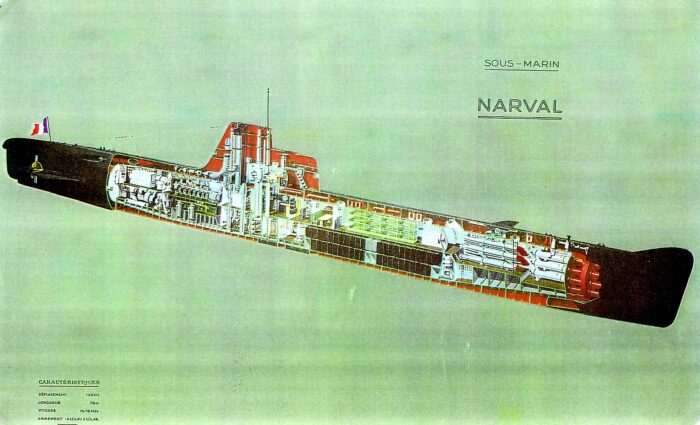
The hulls of the Narvals were assembled from seven 10-metre (33 ft) sections welded together. The welding technique were also new compared to those used prewar. Still, construction of the Narval and Marsouin encountered some difficulties. Dupont de Dinechin already when construciton was well advanced, doubted about pressure resistance in the forward sections and wanted to test an 1/10 scale model in pool, seeing the front cap leaked even before reaching its maximum immersio, thus a reinforcement bar system was installed before launch.
The engine were two-stroke diesels made by the French constructor Schneider, which proved unreliable and noisy (see later) but from 1966 to 1970, the Narvals underwent extensive modernisation, where their engines were replaced by a diesel-electrical design based on the SEMT-Pielstick 12PA4-185 (see later). The two stern torpedo tubes were deleted, electronics were replaced, and the conning tower was replaced by a more modern sail plan from the Daphné class.
Powerplant
Problems were experienced in finding a suitable diesel, as few French engineering firms were willing to undertake a series of only twelve engines. Schneider 2-stroke diesels were chosen in preference to 2/4-stroke Sulzer and 4-stroke MAN diesels. This proved ill-suited as they were criticized as being unreliable and noisy.
Compared to the Type XXI, the Narval class had also a new schnorchel system and gained 33% operational range on electric power alone, 400 nautical miles or 740 km (460 mi) compared to the 290 nmi (540 km; 330 mi) of the original type XXI), and the extremelmy robust hull allowed to doubled the test depth, again compared to the Type XXI. Propellers were also studied to minimise noise, albeit this was jeopardized by the early diesels.
When fast diesels later became available it was decided to replace the machinery by a diesel-electric installation. Three SEMT Pielstick PA 4 12cyl diesels, each rated at 750bhp, replaced the Schneider units. Much more silent, they enabled discreet operation at last.
New electric motors each of 2500hp were also installed, and to these were added a pair of electric cruise motors each of 40hp. All six boats were taken in hand from 1965 onwards, and besides the replacement of the propulsion system major improvements were made to the weapons and detection equipment.
When first completed the Narval class were subjected to extensive trials. In 1958 Dauphin established a record of forty-two days snorkelling. Only the propulsion system proved less than satisfactory. But the reconstruction during 1965-70 was a complete success. Marsouin had a serious fire on 4 August 1978 but was subsequently repaired.
These boats after refit could have 90 days of autonomy and stay submerged for 5-6 days. Crush depth was estimated below 400 m with a normal operaiton depth at 200 m.
Armament
In addition to the six bow tubes, two tubes were fitted aft outside the pressure hull and fourteen torpedoes were carried. At first, the Narval class came out with a more modern and classic armament, with all tubes in the pressure hull, none external. Six were in the bow, two in the stern. However the two stern tubes were removed and the number of torpedoes carried was increased to twenty. The fin was rebuilt as well again.
The torpedo used were likely when completed in 1957 prewar models such as the 55 cm (21.65″) 24V/24M.
These 1924 models had been modernized in the late 1930s and were capable of 4,400 yards (4,000 m) at 45 knots and 8,750 yards (8,000 m) at 35 knots with a 915 lbs. (415 kg) TNT warhead.
There were studies in 1944 on an oxygen-fueled turbine engine model capable of 3,300 yards (3,000 m)/55 knot and 19,700 yards (18,000 m)/40 knots but it never passed the prototype stage.
So it’s likely these had to wait until 1960 to receive modern modesl, such as the E12, 14, 15 or 18 that emerged from 1955 studies.
They also could have tested the 55 cm (21.65″) K2 from 1956, Powered by an Oxygen-alcohol combustion to 1,000 yards (900 m) at 50 knots and carrying a 617 lbs. (280 kg) HBX-3 warhead.
This 173 in (4.400 m) model weighted 2,433 lbs. (1,104 kg) but few data is available.
We start with the E12, first French passive homing torpedo.
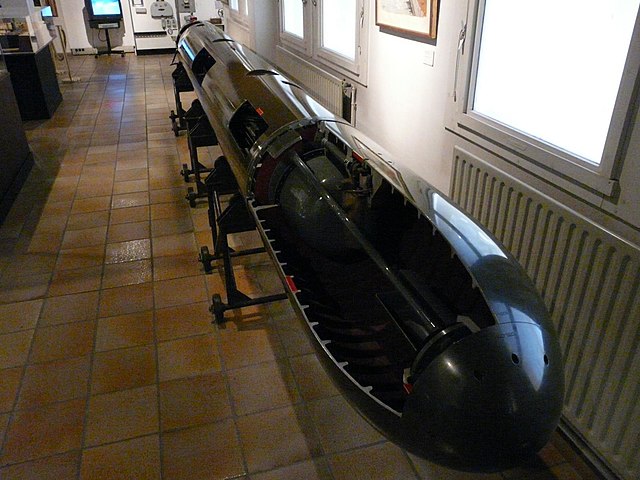
Z13 Torpedo in Toulon Museum
This first French Passive-homing torpedo had to start for guidance with a firing solution delivered within 770 yards (700 m) of the target, developed based from captured German models such as the T-5. It was electric, and range was priomirdial over speed, with justy 25 knots.
Later the shorter E14 was developed for the Arethuse class. The E15 was an export variant of the E12, and the E18 had an improved passive seeker head.
It’s likely they were upgraded to the F17 wire guided from 1973 onwards or the even L5. All these models had the same 55 cm caliber (21.65 inches) instead of classic 53 cm.
In regular service, these subs carried the E12 or Z13. The latter, were 1740 kg models. The Z13 was a 1950s pattern runner developed from the German LUT design.
Only Dauphin in 1980 tested the SM39 Exocet SSM.
⚙ specifications 55 cm E12 |
|
| Weight | 3,637 lbs. (1,650 kg) |
| Dimensions | 7 m x 55 cm (23 ft long) |
| Propulsion | Battery |
| Range/speed setting | 13,000 yards (12,000 m)/25 knots |
| Warhead | 727 lbs. (330 kg) HBX/TNT |
| Guidance | Initial data, passive homing |
⚙ specifications 55 cm Z13 |
|
| Weight | 3,637 lbs. (1,650 kg) |
| Dimensions | 7.125 m x 550 mm (23 ft 5 in long) |
| Propulsion | Electric, two countrarotating propellers |
| Max depth | >1000 m |
| Range/speed setting | 5,500 yards (5,000 m)/25 knots (46 km/h; 29 mph) |
| Warhead | 300 kg TNT/Aluminium/HBX-3 |
| Guidance | Initial data, passive homing |
Sensors
DSUV2 passive listening sonar, with chart recorders
Nautilus acoustic rangefinder to calculate the exact distance from the noisemaker, crossed by 3 reception sources with microphones placed forward, aft and amidship.
Two sound emission interceptors: A direction interceptor and frequency interceptor sensors.
After refit they had the following:
-DUUA-1 sonar
-DUUA-2 (active)+ DUUA-2 (passive) sonar
-DUUX-2 sonar

Conway’s profile

Author’s rendition, 1955 trials, dark emerald green livery

Author’s rendition, 1970 post refit black livery
⚙ specifications |
|
| Displacement | 1,635 tons surfaced, 1,910 tons submerged |
| Dimensions | 78.4 x 7.8 x 5.2m (257 ft 3 in x 25 ft 7 in x 17 ft 1 in) |
| Propulsion | 2 shafts 7-cyl. diesel (4,400 hp/3,300 kW), 2 EM (5,000 hp/3,700 kW) |
| Speed | 16 knots (30 km/h) surfaced, 18 knots (33 km/h) submerged |
| Range | 15,000 nautical miles (28,000 km) at 8 knots (15 km/h) |
| Armament | 8 × 550 mm (22 in) torpedo tubes: 6 bow, 2 stern, 14 carried |
| Test depth | 400 m (1,300 ft), 200 m common navigation (650 m) |
| Sensors | Sonar, radar |
| Crew | 63 |
Prelude: La Creole class

The first postwar french submarines were in fact prewar ones. Laid down in 1937-39 at AC Dubigeon and Augustin-Normand they were uncomplete and seized on slip in 1940, but the first, La Creole, which hull has been launched and was towed to UK where she stayed for the remainder of the war. She was transferred back to France and completed in 1949 like the other four: L’Africaine, L’Astree, L’Andromede and L’Artemis. They all retained the prewar external TTs, four amidship and sux more classic underater tubes, four at the bow and two at the stern. However the less advanced Artesis and Andromede were rebuilt and the front hull was streamlined and integrated a bulge for a passive sonar, as they also had a streamlined fin and GUPPY-style snorkel. They were discarded in 1961-67.
Specs:
970t surf/1250 sub, 73.5 x 6.5 x 4.2m (241 x 21 x 14ft), 2 shaft Sulzer/Schneider diesels, 2 EM, 3000/1400 bhp, 15.5/9.3 kts, RA 8800 nm/10 kts, 10x 550 mm TTs, some 88 mm, 2x 20 mm AA.
Career of the Narval class
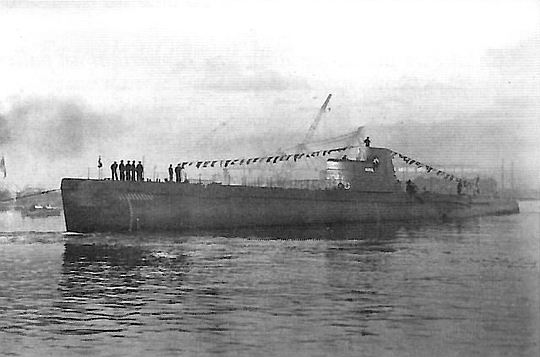
The launch of Narval in 1954 (Marine Nationale coll.)
The start of their career was marred with engine issues. A political decision was made to force the adoption of Schneider diesels in order give national industry a chance again. However the company was not ready to deliver a product tailored for submarines yet, being less experienced than Sulzer. Narval’s endurance cruise was cut short after several engine failures, in 1957, and both Dauphin and Requin had to fold back to port in 1958 and afterwards. In addition noise was excessive in the engine compartment, with 112 decibels at full speed, making crew operation extremely difficult. Performances were there, but the level of noise ws overwhelming. This was a major vice only cured by a systematic overhaul in 1966-70 with new SEMT units that cured all issues.
The Narvals still also explored limits of underwater or surfaced performances and by 1958, Dauphin and Requin broke the 30-day world record for the longest underwater cruise held jointly by USS Skate and USS Seawolf, with 32 and 42 days submerged respectively. In 1964, Espadon and Marsouin sailed up to the 70th parallel north for the first French undersea ice cruise, with tests carried out the next year by Dauphin and Narval, and the 10 days north of the 72nd parallel. In her last years 1980 Requin tested a bow sonar system planned for the Redoutable cmass SSBN M4 refit whereas Dauphin was extensively modified from 1986 as test bed for equipment and sensors intended for the Triomphant-class SSBN. She was the last decommissioned, in 1992, oldest French submarine in service ever,expended as a target ship off Toulon. In 1985, Espadon was saved from the scrapyard and converted as a museum ship.
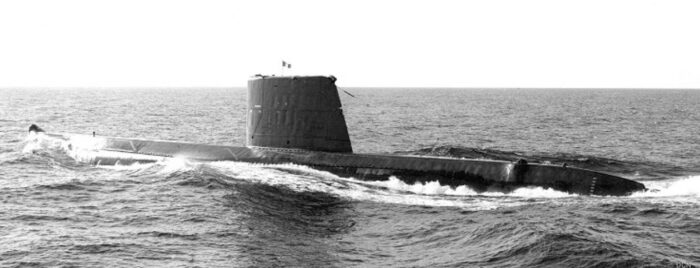
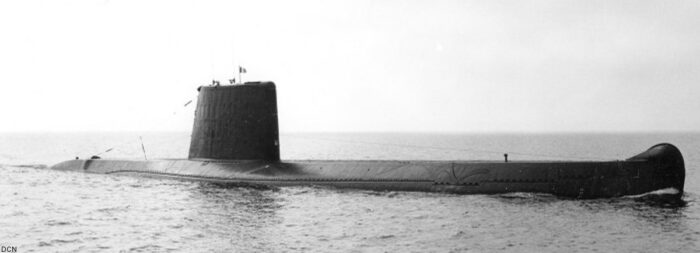
Marsouin after refit. src seaforce.org
The submarines of the Narval class continued in service with the Atlantic Squadron into the mid-1980s. Navral was fitted with a swimmer delivery vehicle in an open-topped container fitted to the after deck casing. Requin was modified for trials of the SM-39 missile in 1980. Marsouin was decommissioned in November 1982 to provide spares for the submarines remaining in service, and Espadon became a museum exhibit after paying off in 1985. In 1986 Dauphin was fitted with the prototype bow section for the Améthyste class SNA, which extended her length overall by 2.97m.
The 1966-70 Refit
This was done by DCAN in Lorient, Keroman base. The propulsion unit was replaced by a diesel-electric propulsion comprising three SEMT-Pielstick 12PA4-185 engines from Chantiers de l’Atlantique engine department and the rear tubes were removed while the old style fin, similar to Creole class subs, was replaced by a model similar to the new Daphne type fins and habitability was also improved. In the central command center, all displays were modernized as well, new radar and sonars were installed.
All six Narval initially were assigned to the 2nd squadron in Lorient, patrolling the Atlantic, Indian Ocean and Pacific Ocean and still had quite original livery in dark green like prewar subs, but in attempt to obtain a better camouflage, engineers originally used a “spinach green” unless its cost forced a return to matt black, hardly more visible.
 Narval
Narval
“Narwhal”, number S631, was the first postwar custom-built French conventional attack submarine, head of the class. Laid down in October 1951 and launched on December 11, 1954.
Her career is marked by a diving depth record, a polar cruise and two accidents: On May 3, 1962, while in periscopic immersion, she was rammed by the tanker “British Vision”. Damage was significant as her fin was mushed and her masts twisted, she needed lengthy repairs.
Narval made history in 1965 with Dauphin during operation Sauna, a polar cruise in the Norwegian Sea.Narval and the Dauphin were the first French submarines to navigate under ice, remaining around ten days post 72° lat. North, from polynia to polynia to validate navigation in polar seas for future Le Redoutable SSBNs.
On April 3, 1966, while trying to sail ot of the anchorage at Glénans, three crew members and the captain fell into the sea as the boat was rocked by a wave almost 90% in a storm. Only three lifeless bodies were found.
She was modernized in 1966-70 and like the other was based in Lorient all her career. She was decommissioned on June 15, 1983 and sold for scrap.
 Marsouin
Marsouin
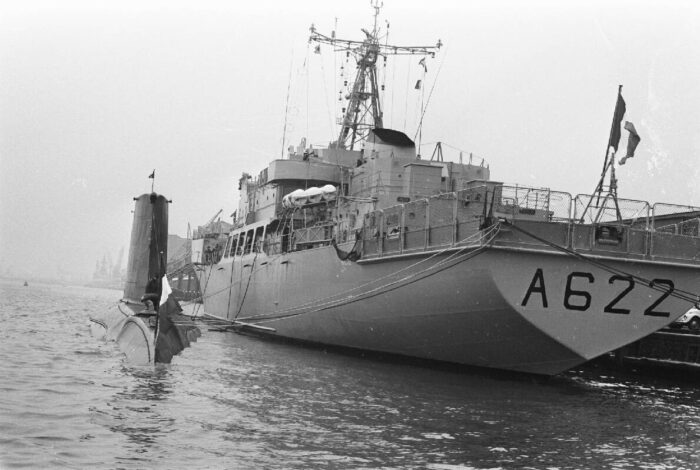
Marsouin in Amsterdam, Source: Beeldbank Nationaal Archief. CC-BySa. Photographer Bert Verhoeff/Anefo, 22 January 1970.
“Porpoise” (Q232, S632) was laid down in Septembre 1951 at the same state yard of Cherbourg, launched 21 may 1955 and commissioned on 1st octobre 1957. She was based in Lorient in her career. Se also had accidents: On November 16, 1960, she was rammed while at periscopic immersion, by an unknown vessel in the Atlantic. Damage to her fin and masts needed lengthy repairs. On November 3, 1961, she was boarded by the coaster Carentan off the coast of Lorient. The bow and sonar mask were mushed, but there were no injuries. On November 11, 1975, she developed a leak broke while diving under 200 meters in the Bay of Biscay. She resurfaced but the acid from electrical accumulators spilled after a strong list and six crewmen were intoxicated but survived. By August 5, 1977, while under refit in Lorient there wete successive explosions at an oil station close to where she was in refit. This left one worker dead and 7 injured, several seriously burned.
Marsouin was modernized in 1966-70 and descommissioned on 4 October 1982.
 Dauphin
Dauphin
“Dolphin” was laid down on January 1952, launched 17 septembre 1955 and commissioned on 29 may 1958. Same as the others, 2nd SubRon at Lorient.No notable accident in her career.
On February 27, 1967, she left Lorient with Galatee via Funchal and back to Lorient on March 1963.
On September 23, 1968 she left Lorient with Narval and the tanker Rhône for manoeuvers in the Bay of Biscay, Franco-Spanish exercise “Finisterex”. She stopped at Vilagarcía de Arousa, Vigo and Marín and was back in October 1954.
Close to decommission, Dauphin was fitted with the prototype bow section for the Amethyste class SSN and reached 81.4m. This was in order to develop Le Triomphant class SSBNs sonars. This was a new carrer as experimental boat after a first overhaul between 1984 and 1986 with torpedo tubes removed, replaced by the spherical sonar array protected by a hemispherical PVC dome of the intended SSBN. She also tested a new towed antenna for receiving very long frequency communications. A second refit in 1989-1990 saw the installation of lateral sonar antennas and a very low frequency towed antenna winch. Dauphin tested the whole future SSBN panoply. Between 1986 and 1989 and 1990-1992 she trialled trese over 500 days at sea to validate capabilities of these new systems.
She was decommissioned in october 1993 and sunk as target on 17 décembre 2003.
 Requin
Requin
“Shark” (S634) was laid down in june 1952 at Cherbourg, launched 3 dec. 1955 and commissioned on 1st august 1958. Like above, 2nd SubRon Lorient for most of her career and overhauled, modernized in 1966-70. In 1979, the Apollo, a Guilvinec trawler accidentally entangled the Shark in her nets. Fortunately she did not capsize.
From 1980 until decommission she served as experimental submarine for the new tactical weapons system (SAT) and multifunction sonar for the modernized M4 SSBNs Inflexible, top secret experiments. After decommission she was sunk as target in the Mediterranan on 31 mai 1996.
 Espadon
Espadon
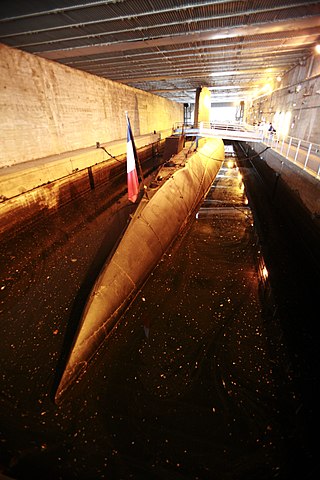 “swordfish” (S637) was the only built at the private Augustin Normand Yard, laid down on December 1955 (Jan 1956 other sources), launched 15 sept. 1958, completed in May 1960. Same as the others.
“swordfish” (S637) was the only built at the private Augustin Normand Yard, laid down on December 1955 (Jan 1956 other sources), launched 15 sept. 1958, completed in May 1960. Same as the others.
She had incident in her career: In September 1961, she collided with Laubie. On August 13, 1963, a fire started in the torpedo compartment which injured four submariners, one of whom later died. In April-May 1964, with Marsouin she dived for 21 days under the ice, Norwegian Sea.
On September 10, 1985, she left Lorient for her last mission, with all 15 of her former commander on board. Back home after decommission the following day, she was towed from Saint-Nazaire on August 23, 1986 in her final place to start a nexw career as a museum, with a WW2 german sub pen modified to accommodate her with a full exhibit. She was the first French sub opened to the public.
Visit Espadon in St Nazaire.
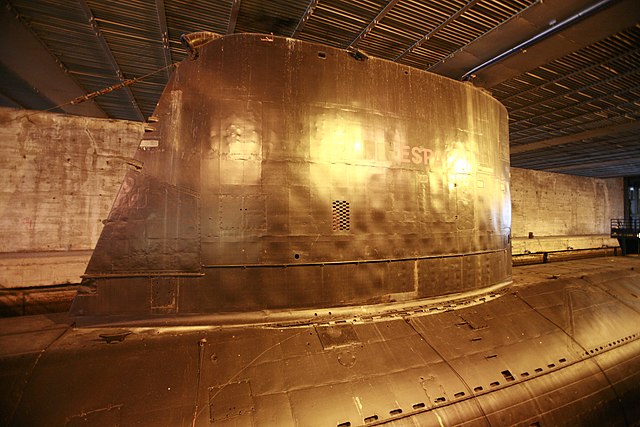
 Morse
Morse
“walrus” (S638, Q238) was built in another private yard, AC de la seine Maritime (Ateliers et chantiers de la Seine-Maritime, Le Trait). She was laid down on February 1956, launched 10 December 1958 and completed the last in her class by May 1960. A military dog named Woodpecker boarded Morse from 1958 to April 1, 1967 statying board for 12,023 diving hours with an official mission to first detect carbon monoxide and carbon dioxide. The pet was also the last dog ever to sail on a French navy submarine. Morse ended in the nets of the trawler Apollo 5 years after the Requin accident. By February 1966, during a Franco-British exercise under periscopic depth, she hit an unidentified object which damaged her forward sonar and she was repaired in Lorient.
cMorese was decommissioned and stricken in 1986, in reserve until 23 july 1990, sold for BU to a Naples compmany by march 1991.
Read More/Src
Books
Jean Meyer et Martine Acerra, Histoire de la marine française : des origines à nos jours, Rennes, Ouest-France, 1994
Michel Vergé-Franceschi (dir.), Dictionnaire d’Histoire maritime, Paris, éditions Robert Laffont 2002
Alain Boulaire, La Marine française : De la Royale de Richelieu aux missions d’aujourd’hui, Quimper, éditions Palantine, 2011
Rémi Monaque, Une histoire de la marine de guerre française, Paris, éditions Perrin, 2016
Links
netmarine.net/ generalites.htm
netmarine.net narval/caracter.htm
navypedia.org/ fr_ss_narval57.htm
navweaps.com/ FR torpedoes
netmarine.net/ main Narval class
netmarine.net/ morse/
philippeberiou.fr/SM_Narval
alabordache.fr/
agasm.fr Les-1200T.pdf
sous.marins.disparus.free.fr
u-boote.fr/marsouin.htm
u-boote.fr/requin.htm
u-boote.fr/morse.htm
mechtraveller.com/ espadon-saint-nazaire/
sous.marins.musees.free.fr
sous-mama.org/
sous.marins.disparus.free.fr/
seaforces.org/
anciens-cols-bleus.net/ espadon
en.wikipedia.org French_Narval-class_submarine
nice photo (copy) on shipspotting.com/
Videos
See also a full visit of Espadon and polar cruise
Model Kits
None so far
3D
Narval by Yannick Le Bris on Sketchfab


 Latest Facebook Entry -
Latest Facebook Entry -  X(Tweeter) Naval Encyclopedia's deck archive
X(Tweeter) Naval Encyclopedia's deck archive Instagram (@navalencyc)
Instagram (@navalencyc)





 French Navy
French Navy Royal Navy
Royal Navy Russian Navy
Russian Navy Armada Espanola
Armada Espanola Austrian Navy
Austrian Navy K.u.K. Kriegsmarine
K.u.K. Kriegsmarine Dansk Marine
Dansk Marine Nautiko Hellenon
Nautiko Hellenon Koninklije Marine 1870
Koninklije Marine 1870 Marinha do Brasil
Marinha do Brasil Osmanlı Donanması
Osmanlı Donanması Marina Do Peru
Marina Do Peru Marinha do Portugal
Marinha do Portugal Regia Marina 1870
Regia Marina 1870 Nihhon Kaigun 1870
Nihhon Kaigun 1870 Preußische Marine 1870
Preußische Marine 1870 Russkiy Flot 1870
Russkiy Flot 1870 Svenska marinen
Svenska marinen Søværnet
Søværnet Union Navy
Union Navy Confederate Navy
Confederate Navy Armada de Argentina
Armada de Argentina Imperial Chinese Navy
Imperial Chinese Navy Marinha do Portugal
Marinha do Portugal Mexico
Mexico Kaiserliche Marine
Kaiserliche Marine 1898 US Navy
1898 US Navy Sovietskiy Flot
Sovietskiy Flot Royal Canadian Navy
Royal Canadian Navy Royal Australian Navy
Royal Australian Navy RNZN Fleet
RNZN Fleet Chinese Navy 1937
Chinese Navy 1937 Kriegsmarine
Kriegsmarine Chilean Navy
Chilean Navy Danish Navy
Danish Navy Finnish Navy
Finnish Navy Hellenic Navy
Hellenic Navy Polish Navy
Polish Navy Romanian Navy
Romanian Navy Turkish Navy
Turkish Navy Royal Yugoslav Navy
Royal Yugoslav Navy Royal Thai Navy
Royal Thai Navy Minor Navies
Minor Navies Albania
Albania Austria
Austria Belgium
Belgium Columbia
Columbia Costa Rica
Costa Rica Cuba
Cuba Czechoslovakia
Czechoslovakia Dominican Republic
Dominican Republic Haiti
Haiti Hungary
Hungary Honduras
Honduras Estonia
Estonia Iceland
Iceland Eire
Eire Equador
Equador Iran
Iran Iraq
Iraq Latvia
Latvia Liberia
Liberia Lithuania
Lithuania Mandchukuo
Mandchukuo Morocco
Morocco Nicaragua
Nicaragua Persia
Persia San Salvador
San Salvador Sarawak
Sarawak Uruguay
Uruguay Venezuela
Venezuela Zanzibar
Zanzibar Warsaw Pact Navies
Warsaw Pact Navies Bulgaria
Bulgaria Hungary
Hungary

 Bundesmarine
Bundesmarine Dutch Navy
Dutch Navy Hellenic Navy
Hellenic Navy Marina Militare
Marina Militare Yugoslav Navy
Yugoslav Navy Chinese Navy
Chinese Navy Indian Navy
Indian Navy Indonesian Navy
Indonesian Navy JMSDF
JMSDF North Korean Navy
North Korean Navy Pakistani Navy
Pakistani Navy Philippines Navy
Philippines Navy ROKN
ROKN Rep. of Singapore Navy
Rep. of Singapore Navy Taiwanese Navy
Taiwanese Navy IDF Navy
IDF Navy Saudi Navy
Saudi Navy Royal New Zealand Navy
Royal New Zealand Navy Egyptian Navy
Egyptian Navy South African Navy
South African Navy






























 Ukrainian Navy
Ukrainian Navy dbodesign
dbodesign